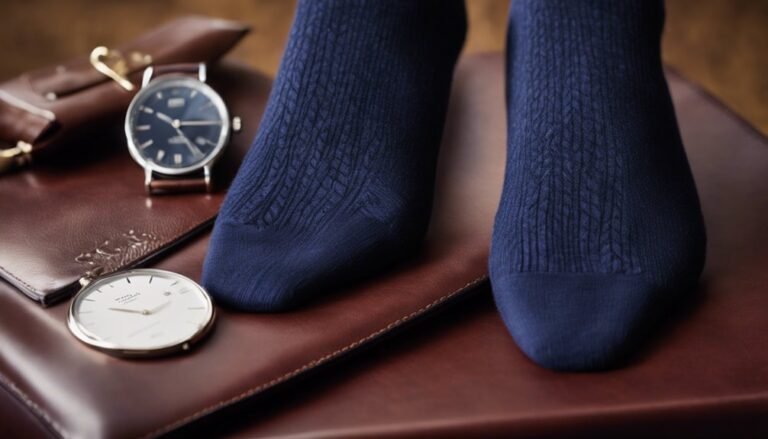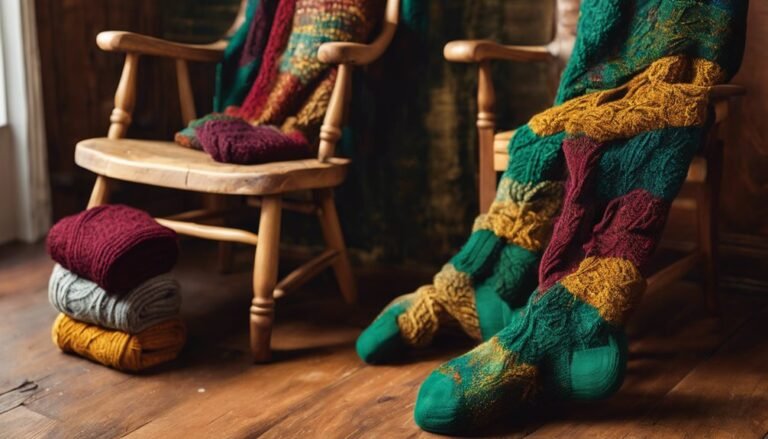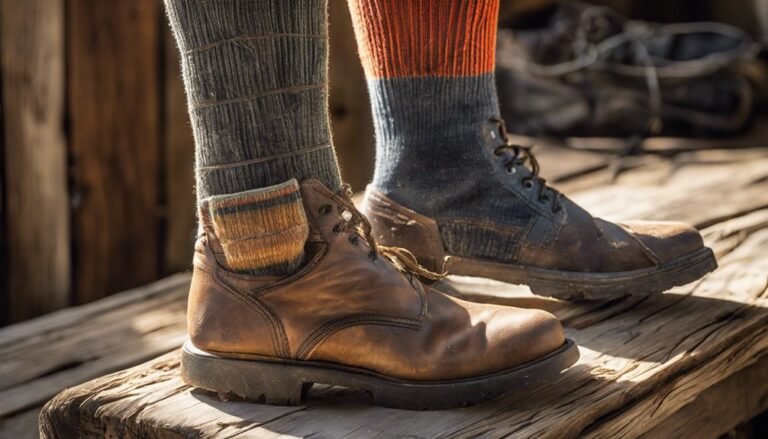Thermal Socks vs. Regular Socks: Which Keeps Feet Warmer?
When comparing thermal socks to regular socks, you'll find thermal options provide superior warmth due to enhanced insulation and moisture-wicking properties. Thermal socks utilize specialized materials that trap heat more effectively and keep your feet dry, reducing the risk of cold, damp feet. Their thicker construction absorbs impact and improves comfort, especially in cold conditions. If you're curious about specific features to evaluate in sock selection, there's much more to explore on this topic.
Understanding Sock Materials
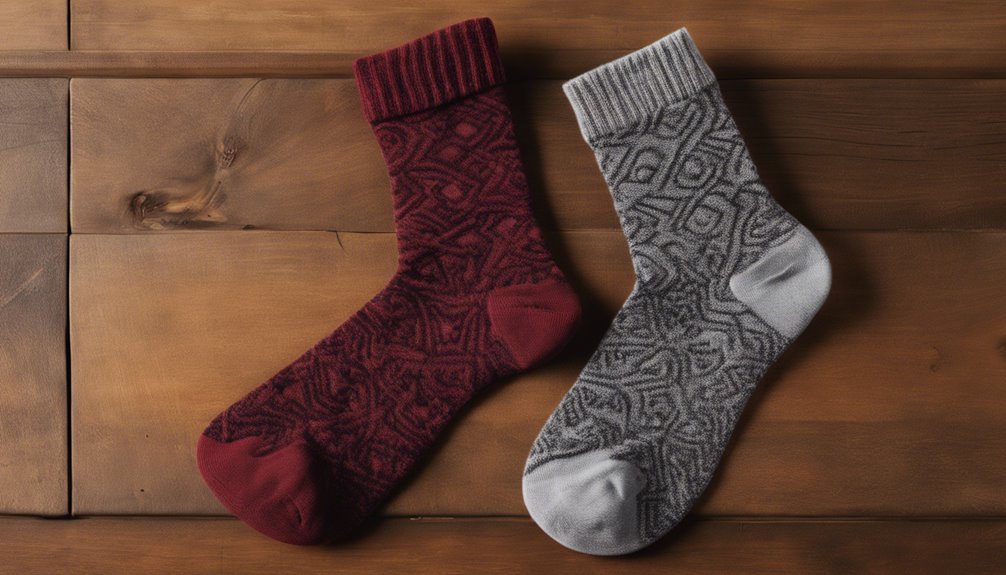
When considering the best socks for warmth and comfort, it's vital to understand the materials that make them effective. High-quality sock materials like merino wool, synthetic blends, and bamboo are prime for thermal insulation. Merino wool excels in moisture management while providing exceptional warmth, making it a favorite among outdoor enthusiasts. Synthetic materials, such as polyester and nylon, offer durability and quick-drying properties, necessary for active lifestyles. Bamboo fibers, on the other hand, provide natural breathability and antimicrobial benefits. Each material has unique thermal properties, contributing to the overall effectiveness of thermal socks. By selecting the right combination of sock materials, you can guarantee your feet remain cozy, dry, and comfortable, empowering your freedom to explore in any environment.
The Importance of Insulation
Insulation is vital for maintaining warmth in your feet, especially in cold conditions. The heat retention properties of thermal socks largely depend on their material composition, which can considerably affect performance. Additionally, effective moisture-wicking capabilities are essential to prevent dampness, ensuring your feet stay warm and comfortable.
Heat Retention Properties
While many underestimate the significance of heat retention, it plays an essential role in determining the effectiveness of thermal socks compared to regular ones. Understanding thermal efficiency is key; higher heat retention means warmer feet.
| Property | Thermal Socks |
|---|---|
| Insulation Level | High |
| Moisture Wicking | Excellent |
| Breathability | Moderate |
| Weight | Lightweight |
| Durability | Long-lasting |
When you evaluate your sock choices, consider these properties. Thermal socks are designed to trap and retain heat more effectively, ensuring your feet stay warm in cold conditions. By prioritizing heat retention, you gain the freedom to explore the outdoors without the discomfort of cold feet.
Material Composition Factors
Material composition is a critical factor in the performance of thermal socks, as the right materials greatly enhance their insulating properties. Cotton advantages lie in its softness and breathability, making it comfortable for casual wear. However, it doesn't provide adequate insulation in extreme temperatures. On the other hand, wool benefits from its natural insulating abilities, trapping heat effectively even when wet. Merino wool, specifically, offers superior warmth without bulk, making it an ideal choice for thermal socks. Its moisture-wicking properties keep feet dry, further enhancing comfort. When choosing thermal socks, consider the balance of materials: while cotton may suit milder conditions, wool is essential for cold environments, ensuring your feet remain warm and cozy.
Moisture-Wicking Capabilities
When choosing thermal socks, moisture-wicking capabilities play an essential role in maintaining warmth and comfort. Effective moisture management is critical; without it, sweat accumulation can lead to cold, damp feet, especially in colder environments. Thermal socks designed with advanced moisture-wicking materials actively promote sweat evaporation, drawing moisture away from your skin. This process not only enhances comfort but also prevents chilling, which occurs when wet fabric clings to your feet. Research indicates that socks with superior moisture control can reduce the risk of frostbite and hypothermia in extreme conditions. Consequently, selecting thermal socks with excellent moisture-wicking properties guarantees your feet stay dry, warm, and ready for any adventure, allowing you the freedom to explore without worry.
Moisture-Wicking Properties
Moisture-wicking properties are essential for maintaining comfort during physical activities, and thermal socks excel in this area compared to regular socks. These socks utilize advanced materials designed for superior moisture management, effectively drawing sweat away from your skin. This promotes sweat evaporation, keeping your feet dry and reducing the risk of blisters and discomfort. Regular socks, often made from cotton, tend to absorb moisture rather than wick it away, leading to damp feet and potential chill. In contrast, thermal socks are engineered with synthetic fibers or merino wool, which are inherently better at managing moisture. By choosing thermal socks, you guarantee your feet remain warm and dry, allowing you to enjoy your activities without the distraction of soggy, cold feet.
Thickness and Cushioning

Thickness and cushioning play essential roles in the performance and comfort of socks, especially when comparing thermal socks to their regular counterparts. When evaluating these aspects, consider the following:
- Cushioning Benefits: Thermal socks often include additional padding, which absorbs impact and reduces fatigue during long wear.
- Thermal Retention: The thicker material in thermal socks traps more air, providing better insulation and warmth compared to standard socks.
- Weight and Flexibility: While thicker socks offer added warmth, they can also affect the flexibility of your footwear, making it vital to find a balance.
Understanding these factors can help you make an informed decision, ensuring your feet stay warm and comfortable during colder months without sacrificing mobility.
Fit and Comfort
When comparing thermal socks to regular socks, the differences in material can greatly affect fit and comfort. Thermal socks often incorporate thicker insulation, which can alter how they conform to your foot and may lead to a snugger fit. Understanding these distinctions is essential for selecting the right sock for your activities and ensuring ideal comfort throughout the day.
Sock Material Differences
Different sock materials markedly impact fit and comfort, influencing your overall experience. Understanding these differences helps you make informed choices for warmth and comfort.
- Wool: Renowned for its excellent thermal properties, wool can wick moisture while providing insulation, making it ideal for sock layering.
- Synthetic Blends: Often designed for breathability and stretch, synthetic materials can enhance fit, allowing for a snug yet comfortable wear.
- Cotton: While comfortable, cotton's moisture retention can lead to cold, damp feet. It's less effective in providing warmth compared to other materials.
Thickness and Insulation
Sock material choices directly affect the thickness and insulation properties, which can greatly impact your comfort during various activities. When considering thermal socks versus regular socks, the thermal performance hinges on insulation effectiveness. Thicker materials, such as merino wool or advanced synthetic blends, typically offer superior insulation by trapping air and maintaining warmth. Conversely, thinner socks may lack the necessary thermal properties, leaving your feet vulnerable to cold conditions. It's vital to assess the specific environment you'll be in; for example, if you're engaging in high-energy activities, a balance between thickness and breathability can enhance overall comfort. Ultimately, selecting the right sock thickness is important for optimizing your experience, ensuring your feet stay warm without compromising mobility or comfort.
Design and Fit
The design and fit of thermal socks play an essential role in their overall effectiveness and comfort. When choosing the right thermal socks, consider the following key aspects:
- Material Composition: Look for blends that include wool, which offers superior insulation and moisture-wicking capabilities.
- Design Styles: From knee-high to ankle-cut, each style serves specific needs, affecting warmth and breathability.
- Fit Variations: Guarantee a snug yet comfortable fit to prevent bunching, which can lead to cold spots.
A well-designed thermal sock not only enhances warmth but also promotes freedom of movement. When you prioritize these elements, you'll optimize both comfort and thermal efficiency, guaranteeing your feet stay warm in even the coldest conditions.
Breathability and Temperature Regulation
While you might think all socks are created equal, their breathability and temperature regulation can greatly impact comfort, especially in varying conditions. Breathable fabrics enhance airflow, preventing moisture buildup, which is essential for maintaining ideal temperature control. Thermal socks often incorporate advanced materials designed to wick away sweat while insulating warmth, making them ideal for colder climates.
| Feature | Thermal Socks | Regular Socks |
|---|---|---|
| Breathability | Moderate to High | High |
| Moisture Wicking | Excellent | Varies |
| Insulation | High | Low |
| Temperature Control | Superior | Moderate |
| Ideal Temperature Range | Cold to Cool | Cool to Warm |
Ultimately, choosing the right type of sock can greatly enhance your comfort and freedom to move.
Durability and Longevity
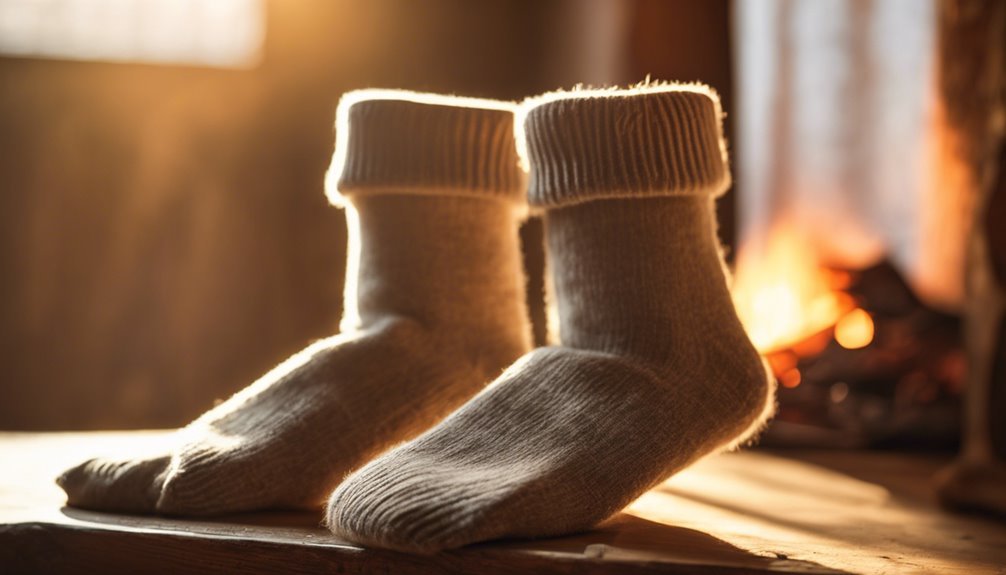
When comparing thermal socks to regular socks, you'll notice significant differences in material quality that impact durability. Regular wear and tear can vary based on the fabric composition and construction techniques used, influencing how long each type lasts. Additionally, proper care and maintenance can extend the life of both sock types, but the specific requirements may differ based on their materials.
Material Quality Comparison
Many consumers underestimate the impact of material quality on the durability and longevity of socks. When evaluating sock material types, you should consider the following:
- Fabric Composition: Thermal socks often use synthetic blends that enhance thermal insulation effectiveness, while regular socks may rely on cotton, which lacks durability in extreme conditions.
- Weave Density: A tighter weave in thermal socks can improve both warmth retention and resistance to wear, greatly extending their lifespan.
- Moisture Wicking: High-quality thermal socks typically feature moisture-wicking properties that reduce dampness, preventing material breakdown and odor over time.
Wear and Tear
The durability and longevity of socks are considerably influenced by their construction and material properties. When you engage in durability testing, you'll find that thermal socks often outperform regular socks regarding sock lifespan. This is largely due to the use of advanced materials like merino wool or synthetic blends designed to withstand wear and tear better. Regular socks, while comfortable, may not have the same structural integrity, leading to quicker deterioration. Additionally, the knitting techniques employed in thermal socks provide enhanced cushioning and reinforcement, which contributes to their longevity. Ultimately, if you prioritize durability, opting for thermal socks may be your best choice for extended use without compromising comfort or performance.
Care and Maintenance
Effective care and maintenance can greatly extend the lifespan of both thermal and regular socks, but thermal socks require specific attention due to their unique materials. To guarantee durability and longevity, consider these essential tips:
- Cleaning techniques: Always wash thermal socks in cold water and avoid fabric softeners to preserve their insulating properties. Air-drying is preferable to prevent shrinkage.
- Storage tips: Store your socks in a cool, dry place, preferably in pairs to avoid stretching or damage. Avoid folding them tightly.
- Inspection: Regularly check for wear and tear, particularly around the heels and toes, and retire any socks that show significant signs of damage.
Performance in Different Activities
While engaging in various activities, the choice between thermal socks and regular socks can considerably influence comfort and performance. If you're hiking, thermal socks often enhance hiking performance by providing better insulation and moisture-wicking properties, keeping your feet dry and warm. This is vital for extended outdoor activities where temperature fluctuations can lead to discomfort. In winter sports, like skiing or snowboarding, thermal socks help maintain core temperature, reducing the risk of frostbite and allowing for greater mobility. Regular socks may not offer the same level of thermal regulation, potentially leading to cold feet and diminished performance. Ultimately, selecting the right sock type is essential for maximizing comfort and ensuring peak performance in cold conditions.
Cost Comparison
When comparing the costs of thermal socks and regular socks, you'll find a noticeable difference that often reflects their intended use and material quality. Here are some budget considerations to keep in mind:
- Material Quality: Thermal socks use advanced materials, often leading to higher prices.
- Durability: Investing in thermal socks may save money long-term due to their longevity.
- Functionality: Regular socks are typically cheaper but may not provide the warmth needed for cold conditions.
These price differences can considerably impact your budget. If you frequently find yourself in colder environments, spending a bit more on thermal socks could be a wise investment. Balancing your need for warmth with your budget will help you make an informed choice.
Choosing the Right Sock for Your Needs
How do you determine which sock is best suited for your specific activities? Start by identifying the sock purpose—whether it's warmth, moisture-wicking, or cushioning. For outdoor activities in cold weather, thermal socks, made from materials like merino wool, offer superior insulation and moisture management. Conversely, if you're engaging in high-intensity sports, regular socks crafted from synthetic fibers provide breathability and support. Evaluate activity suitability: hiking, running, or lounging each demands different properties. Look for features such as padding, compression, and fit for peak performance. Finally, consider the environment; wet or dry conditions can influence your sock choice. By aligning sock characteristics with your needs, you guarantee comfort and enhance your performance in any activity.
Frequently Asked Questions
Can Thermal Socks Be Worn in Warmer Weather?
Yes, you can wear thermal socks in warmer weather. Their specialized materials often offer temperature regulation, allowing moisture wicking and breathability, which can keep your feet comfortable even in higher temperatures without overheating.
How Do I Wash and Care for Thermal Socks?
To care for thermal socks, use gentle washing techniques in cold water, ensuring you're mindful of the sock materials. Avoid fabric softeners and high heat, as they can compromise insulation properties and durability.
Are Thermal Socks Suitable for People With Sensitive Skin?
Sensitive skin seekers should select soft, smooth thermal sock materials. These specially designed socks offer significant skin benefits, minimizing irritation and maximizing comfort. Always check labels to verify you're choosing the best fit for your needs.
Do Thermal Socks Come in Different Styles or Designs?
Yes, thermal socks do come in various design variations, reflecting current fashion trends. You can find them in patterns, colors, and styles that suit your taste while maintaining their functional benefits for warmth and comfort.
Can I Wear Thermal Socks With Sandals or Open-Toed Shoes?
You can wear thermal socks with sandals, but consider comfort concerns and fashion choices. While it might not be the most stylish look, prioritizing warmth could outweigh any aesthetic drawbacks for some individuals.


